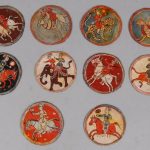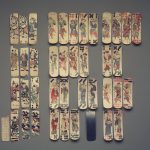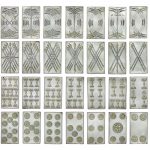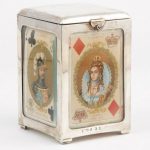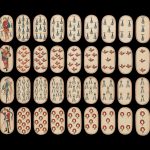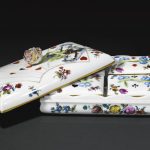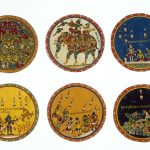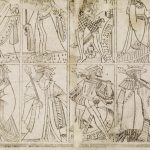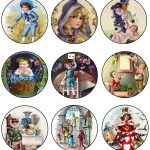Altered playing cards are extremely popular in the crafting world so I have found some excellent antique playing cards on-line as inspiration. My favorite is the set of playing cards which sold at Bonhams. I’m biased because I love fairies and the set shows a beautiful card whose wings form the hearts. To see them at their best simply click on the thumbnail images below. I hope they provide inspiration for your own altered playing cards. If you ever find a set like the ones below, I advise most heartedly not to alter them as it would destroy the historical value of these types of cards. However, you may get the inspiration from them to either make your own similar cards or to scan them and alter the scanned version.
PLAYING CARDS Karten Almanach [complete pack of 52 pictorial playing cards], stippled-engraved, court cards hand-coloured, red pips suits hand-coloured, 16pp. of text in original pink wrappers, together in original green card box case (rubbed but solid), 8vo (100 x 70mm.), Tübingen, J.G. Cotta, 1806 FOOTNOTES A fine complete pack, with the original accompanying text volume, of transformation cards in which the the suit-marks are incorporated into the design of the pip cards. The court cards are whole-length Greek, Persian or Biblical figures (for example Ulysses, Iphigenia, and Mordecai for hearts). The inventive picture cards include groups of children (playing cards, picking apples, sledging, in schoolroom, visiting a Christmas crib), fairies, apothecaries at work, a domestic tea party, music lesson, a huntsman and his dogs, a nightmare, a witch on a broomstick flying with geese, and travelling performers.
Sold for £ 1,875 inc. premium at Bonhams in 2017
Group of lacquered playing-cards, ganjifa
These playing cards are so unusual and are excellent inspiration for ATC coins.
There are more of these at © The Trustees of the British Museum
Domino Cards or Actors’ Cards. Ink and color printed on paper, each: 3 3/8 x 15/16 in. (8.6 x 2.4 cm). Brooklyn Museum, Estate of Stewart Culin, Museum Purchase, 30.417. Creative Commons-BY (Photo: Brooklyn Museum, 30.417.jpg)
Reference: The Brooklyn Museum
AN EXTREMELY RARE SET OF GERMAN ENGRAVED AND PARCEL-GILT SILVER PLAYING CARDS SIGNED MICHAEL FRÖMMER, AUGSBURG, 1616 A complete set of 52 cards engraved in the four Italian suits: swords, batons, cups, and coins, each suit with a king, a knight, a knave, and pip cards ace through ten; the Knave of Swords signed M. frömmer fec, the Ace of Batons dated 1616; with a tooled-leather shadowbox case set with a brass plaque engraved with provenance Each card 3 3/8 in. (8.6 cm.) high, 1 15/16 in. (5 cm.) wide (52) Provenance These cards, according to family tradition, were given to Josefa Oribe y Viana de Contucci, ancestor of the present owner, by Infanta Carlota Joaquina of Spain (1775-1830). Princess Carlota was daughter of King Carlos IV and, as wife of King João of Portugal, Princess of Portugal and Brazil. During Napoleonic struggles, Carlota was exiled to Brazil with the Portuguese Court. When Napoleon forced her father to abdicate in Spain, she became claimant to the throne of Spain and Spanish America. Following the patriotic revolution in Buenos Aires in 1810, she ordered Portuguese-Brazilian troops into Montevideo to protect the interests of the Spanish monarchy. Carlota’s emissary in South America and the director of her military efforts there was Felipe Contucci. Carlota presented these cards to Contucci’s wife, and they descended to the present owner as follows:
Sold for USD 554,500 at Christies in 2010
Edwardian Silver Mounted Playing Card Box Henry Clifford Davis, Birmingham, 1901 Of cube form, the sides with playing cards depicting British Monarchs under beveled glass, spring loaded interior fitted for three decks. Height 4 1/2 inches.
Sold for $1,187 (includes buyer’s premium) at Doyle New York in 2014
The Cloisters Playing Cards Date:ca. 1475–80 Geography:Made in Burgundian territories Culture:South Netherlandish Medium:Paper (four layers of pasteboard) with pen and ink, opaque paint, glazes, and applied silver and gold
The Cloisters set of fifty-two cards constitutes the only known complete deck of illuminated ordinary playing cards (as opposed to tarot cards) from the fifteenth century. There are four suits, each consisting of a king, queen, knave, and ten pip cards. The suit symbols, based on equipment associated with the hunt, are hunting horns, dog collars, hound tethers, and game nooses. The value of the pip cards is indicated by appropriate repetitions of the suit symbol. The figures, which appear to be based on Franco-Flemish models, were drawn in a bold, free, and engaging, if somewhat unrefined, hand. Their exaggerated and sometimes anachronistic costumes suggest a lampoon of extravagant Burgundian court fashions. Although some period card games are named, it is not known how they were played. Almost all card games did, however, involve some form of gambling. The condition of the set indicates that the cards were hardly used, if at all. It is possible that they were conceived as a collector’s curiosity rather than a deck for play.
Reference: The Metropolitan Museum of Art
A Meissen porcelain games set, circa 1760-70 the rectangular case with domed cover and flower finial, painted with six fanned playing cards, one depicting the Queen of Hearts, against a white ground scattered with flower sprays, the interior fitted with four flower painted boxes with stalk handles to the covers, the underside of the case and each box painted with flower groups, traces of crossed swords marks in underglaze-blue to boxes, Quantity: 10 16.5cm., 6 1/2 in. wide
Sold for 5,250 GBP at Sothebys in 2015
Complete set of 96 circular ganjifa cards in 8 suits in a wooden box with sliding lid. The cards are of starched cotton, painted and laquered. The box is of wood, covered with cloth and painted and laquered. Both cards and box are illustrated with scenes from the Ramayana.
Reference: © Victoria and Albert Museum
Uncut Sheet of Printed Playing Cards
Playing cards were invented in China 1,000 years ago but were unknown in Europe before the mid-14th century. It is believed that cards as we know them were introduced to Spain from North Africa when both areas were under Muslim control. French cards, such as those displayed here, are the closest visually to those we use today. These paper cards have yet to be cut and were never used, but the final product would have been fairly affordable.
Reference: The Walters Art Museum

![PLAYING CARDS Karten Almanach [complete pack of 52 pictorial playing cards], stippled-engraved, court cards hand-coloured, red pips suits hand-coloured](https://thejurassicfairy.com/wp-content/uploads/2019/02/playing-cards-almanach-150x150.jpg)
